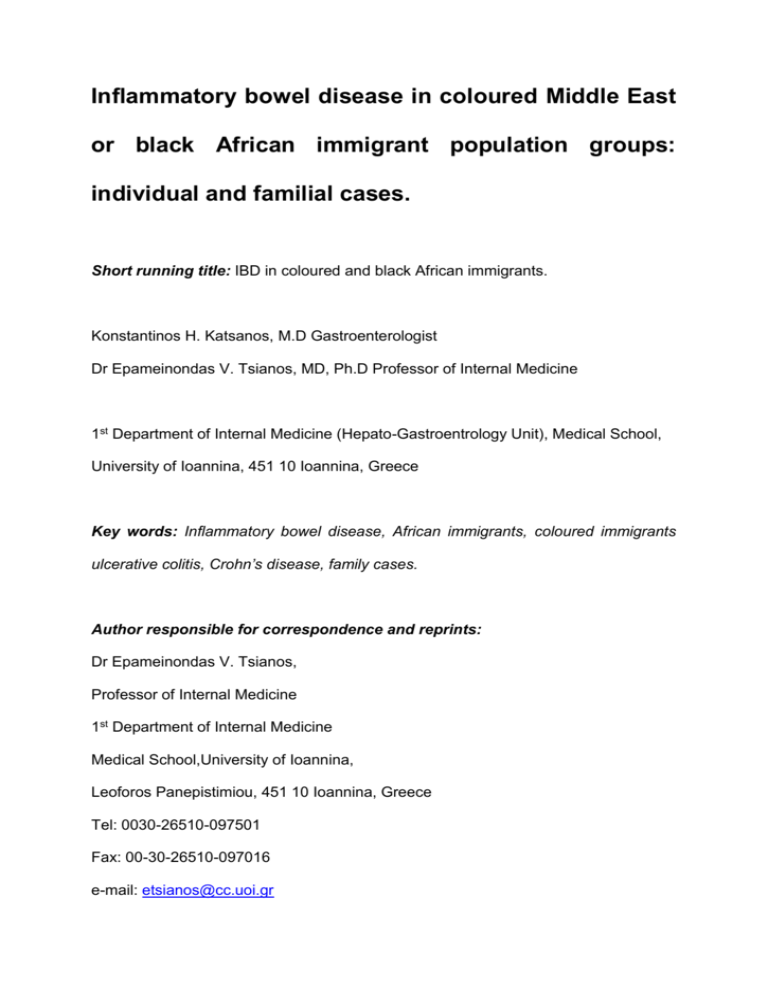There is no information on IBD occurence in refugee populations
advertisement

Inflammatory bowel disease in coloured Middle East or black African immigrant population groups: individual and familial cases. Short running title: IBD in coloured and black African immigrants. Konstantinos H. Katsanos, M.D Gastroenterologist Dr Epameinondas V. Tsianos, MD, Ph.D Professor of Internal Medicine 1st Department of Internal Medicine (Hepato-Gastroentrology Unit), Medical School, University of Ioannina, 451 10 Ioannina, Greece Key words: Inflammatory bowel disease, African immigrants, coloured immigrants ulcerative colitis, Crohn’s disease, family cases. Author responsible for correspondence and reprints: Dr Epameinondas V. Tsianos, Professor of Internal Medicine 1st Department of Internal Medicine Medical School,University of Ioannina, Leoforos Panepistimiou, 451 10 Ioannina, Greece Tel: 0030-26510-097501 Fax: 00-30-26510-097016 e-mail: etsianos@cc.uoi.gr Ackowledgment Dr Konstantinos H. Katsanos is a grant recipient of the Hellenic Society of Gastroenterology for the academic year 2005-2006. Authors notice: The incidence of IBD Greek immigrants in Australia and New Zealand upon their arrival and during the first two decades of immigration is lower compared to native population but on the third decade or after one generation it increases significantly reaching figures of the native population. The second or third generation of Greek immigrants in Australia turn to have the same incidence of IBD as the native Australians (K.H.K, personal communication). 1. Introduction. There is no information available on familial inflammatory bowel disease (IBD) occurrence in refugee populations in general and there rarity of information on IBD epidemiology in African countries or for African immigrants more specially. However, inflammatory bowel disease seems to be less frequent in coloured and black population groups of Africa and Middle East compared to Caucasians in Middle East, Europe and USA. Furthermore IBD in coloured and black population immigrant groups seems to have significantly lower incidence when compared to native white population groups. Interpretation of such epidemiological data must be done with caution as histological support for bowel specimens evaluation in Africa is not largely available. In addition migration towards more accessible health care has not been adequately addressed. Furthermore, a higher incidence of IBD is traditionally associated with a higher average family income and a smaller average family size. 2. IBD in coloured and black population groups (Africans- Middle East) IBD has an extremely low incidence in black Africa. Nearly one year ago the first case of Crohn’s disease was reported in Cote-d’ Ivoire. 1 Twenty-two IBD cases out of 1, 2 million sub-Saharan inhabitants treated as outpatients or admitted in mission hospitals have been reported 2 and in the greater Cape Town area, the incidence of Crohn’s disease and ulcerative colitis was higher in white population groups compared to coloured and black population groups. Black population groups had significantly lower IBD incidence compared to coloured population groups. 3 In Middle East IBD in coloured population groups is lower compared to the immigrant population groups of Caucasian origin. In a study4 in one of the northern districts of Israel (Kinneret) both prevalence and incidence rates of ulcerative colitis were 2.5 times higher among Jews who have immigrated to Israel in the last century from various countries than among native Arabs. In addition, in a southern Israel retrospective study5 it was shown that IBD had a significantly lower incidence in Bedouin Arab population group compared to Jewish population group. In another study from the same region6 and also from central Israel7 ulcerative colitis and Crohn’s disease were commoner in European-American-born Jews compared to Asian-African- born Jews. 3. IBD in coloured and black immigrants. Aboriginal Canadians have significantly lower rates of both Crohn’s disease and ulcerative colitis compared to native Caucasians in the Canadian province of Manitoba.8 In UK, over a 15-year period only 6 patients of Afro-Caribbean origin presented with ulcerative colitis from a community of this ethnic extraction numbering 47,000 persons9 and in Hungary, the Roma (Gypsies) have a considerably lower prevalence than the average population.10 Finally, an epidemiological study of Crohn’s disease in regio Leiden, the Netherlands showed that the lack of Crohn’s disease cases in the migrant population almost reached significant levels when compared to native population. The authors, however, stresses the need for studies in locations with a higher migrant population in order to clarify this issue.11 In addition, it has been reported that the risk of IBD in the coloured and black immigrants increases significantly after the first decade of migration in Europe and America. It seems that prolonged immigration, probably more than a decade, or second generation coloured or black immigrants substantially do share the same as native Caucasian population risk for developing IBD. In Bangladeshis in East London, the incidence of IBD has increased and of abdominal tuberculosis has fallen over the last decade.12 In Birmingham, in a study with 44 Asian immigrants and 44 age- and sex-matched white Caucasians, all of them being diagnosed with ulcerative colitis. It was shown that the age of onset of UC was related to age at immigration with a mean interval of 11 years.13 In the three-year prospective study among Europeans and first- and secondgeneration South Asians in Leicester it was shown that extensive colitis was commoner in second-generation South Asian migrants than in the first generation and was comparable to the European community. Authors suggest that in migrant population ulcerative colitis pattern follows that of indigenous population after only one generation and that it requires monitoring over the next decade. 14 In fact, for immigrants, the mean duration of residence in Canada before developing IBD was 8.9 years for Crohn’s disease patients and 13.5 years for ulcerative colitis patients. No differences were noticed in ANCA seropositive or seronegative immigrant patients regarding age, sex, birth or duration of residence in Canada. 15 Data from USA suggest that rates are similar in Afro-American and Caucasian populations16 and a quite recent study17 showed that inflammatory bowel disease in African-American children living in Georgia may be more common than previously reported. 4. IBD cases and familial IBD cases in coloured and black immigrants. In Canada, the first reported instance of familial Crohn’s disease in an immigrant population was reported four years ago; it is a report of an Indo-Canadian family in which all members developed the disease after prolonged residence in Canada.18 According to the authors this immigrant family case illustrates potential biases in genetically based studies of Crohn’ disease that rely solely on phenotypic expression. In other words, it seems that many people might have IBD in their genetic background but either they never express it phenotypicallly or they express it only under special environmental circumstances such as in the land of immigrance. References 1. Casanelli JM, Keli E, N’Dri J, et al. Crohn’s disease: first report in Cote-d’ Ivoire. Med Trop 2004; 64:384-6 2. Mayberry J, Mann R. Inflammatory bowel disease in rural sub-Saharan Africa: rariry of diagnosis in patients attending mission hospitals. Digestion 1989;44: 172-6 3. Wright JP, Froggatt J, O’ Keefe EA, et al. The epidemiology of inflammatory bowel disease in Cape Town 1980-1984. S Afr Med J 1986;70: 10-15 4. Shapira M, Tamir A. Ulcerative colitis in the Kinneret sub district, Israel 1965-1994: Incidence and prevalence in different subgroups. J Clin Gastroenterol 1998; 27:134-7 5. Odes HS, Locker C, Neumann L, et al. Epidemiology of Crohn’s disease in southern Israel. Am J Gastroenterol 1994; 89: 1859-62 6. Odes S, Fraser D, Krawiec J. Inflammatory bowel disease in migrant and native Jewish populations of southern Israel. Scand J Gastroenterol Suppl 1989;170:36-8 7. Fireman Z, Grossman A, Lilos P, Eshchar Y, Theodor E, Gilat T. Epidemiology of Crohn’s disease in the jewish population of central Israel, 1970-1980. Am J Gastroenterol 1989;84:255-8 8.Blanchard JF, Bernstein CN, Wajda A, Rawsthorne P. Small-area variations and sociodemographic correlates for the incidence of Crohn’s disease and ulcerative colitis. Am J Epidemiol 2001;154:328-35 9. Benfield GF, Montgomery RD, Asquith P. Ulcerative colitis in Asian immigrants. Postgrad Med J 1987; 63:629-35 10. Karlinger K, Gyorke T, Mako E, Mester A, Tarjan Z. The epidemiology and the pathogenesis of inflammatory bowel disease. Eur J Radiol 2000;35:154-67 11. Shivananda S, Pena AS, Nap M, et al. Epidemiology of Crohn’s disease in regio Leiden, the Netherlands. A population study from 1979 to 1983. 12. Tsironi E, Feakins RM, Probert CS, Rampton DS, Phil D. Incidence of inflammatory bowel disease is rising and abdominal tuberculosis is falling in Bangladeshis in East London, United Kingdom. Am J Gastroenterol 2004;99:1749-55 13. Benfield GE, Asquith P. Ulcerative colitis in West Indian immigrants. Q J Med 1986;59:489-95 14. Carr I, Mayberry JF. The effects of migration on ulcerative colitis: a three-year prospective study among Europeans and first- and second-generation South Asians in Leicester (1991-1994). Am J Gastroenterol 1999;94:2918-22 15. Freeman HJ. Inflammatory bowel disease in Indo-Canadians with and without antineutrophil cytoplasmic autoantibodies. Can J Gastroenterol 2000; 14:21-6 16. Farrokhyar F, Swarbrick ET, Irvine EJ. A critical review of epidemiological studies in inflammatory bowel disease. Scand J Gastroenterol 2001; 36:2-15 17. Ogunbi SO, Ransom JA, Sullivan K, Schoen BT, Gold BD. Inflammatory bowel disease in African-American children living in Georgia. J Pediatr 1998;133:130-7 18. Freeman HJ, Hershfield NB. Anticipation in an Indo-Canadian family with Crohn’s disease.Can J Gastroenterol 2001;15:695-8 Ioannina, September 2005 Dear Dr Triantafillidis, I would be grateful if you could consider the enclosed original manuscript: " Inflammatory bowel disease in coloured or black African immigrant population groups: individual and familial cases." for publication as review in Annals of Gastroenterology. Thank you very much for your valuable contribution to the evaluation of this original manuscript. Yours sincerely, Dr Epameinondas V. Tsianos Professor of Internal Medicine Medical School of Ioannina AUTHORS STATEMENT We the undersigned authors agree with the final form of the manuscript and we declare that we have no conflict of interest regarding this manuscript. K.H Katsanos E.V Tsianos









